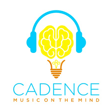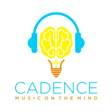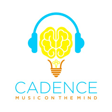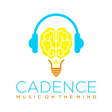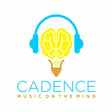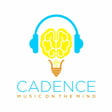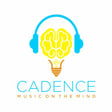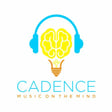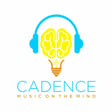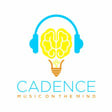Become a Creator today!Start creating today - Share your story with the world!
Start for free
00:00:00
00:00:01

Episode 09: Listening Better
It takes years to train your ears - but not necessarily a music degree. Auditory neuroscientist Nina Kraus tells us how musicians listen and therefore hear differently with training. Orchestral conductor Eric Dudley explains that the secret to getting an orchestra to sync up is teaching them to listen and ukulele player and comedic musician Molly Lewis demonstrates how she taught herself to become a musician by listening better.
Transcript
Introduction to Cadence Podcast
00:00:05
Speaker
Welcome back to Cadence, the podcast where we explore what music can tell us about the mind. I'm your host, Andrea Viscontes. For the last two episodes, we've been exploring how musicians, and non-musicians for that matter, find a pulse in music, and whether musicians have a more accurate neural
Managing Timing in Orchestras
00:00:22
Speaker
clock. At the end of the last episode, we heard from Jack Van Geem, a retired principal percussionist from the San Francisco Symphony,
00:00:29
Speaker
about what happens if his sense of timing differs from the conductor's, or the orchestra and the conductor just aren't lining up. It's a little bit like having to hit a bullseye with a bow and arrow, but you're standing on a moving platform which may or may not be moving in sync with the platform on which the bullseye is placed. Does that make any sense?
00:00:58
Speaker
So how do conductors make sure they're keeping their players in line? I talked to San Francisco Conservatory's newly minted orchestral conductor Eric Dudley to find out. I first asked him how he diagnoses a problem when he's in front of the orchestra. Let's say they're playing Beethoven's 9th and things just aren't going well.
00:01:18
Speaker
The first thing I try to address in front of any orchestra is, are they listening or are they not listening to each other? Because if that's not there, then you have so much work to do. You have to literally find a way of teaching the orchestra to listen to each other. So you actually have to break things down on a section by section basis and say, well, no, no, no, it's this is the oboe's melody for these, you know, three bars. So everybody cue on the oboe or
00:01:45
Speaker
you know, notice the second violins and violas have nothing but running sixteenth notes for this entire passage. That's the core of our rhythm, we latch on to that. You know, so you have to break down pieces in ways that educate the orchestra on what to listen to when. And in other words, how to be chamber musicians. Because the conductor can only be responsible for so much when it actually comes down to the actual rhythmic sense of the ensemble.
00:02:14
Speaker
you can stand up in front of an ensemble and literally be a metronome, just a physical metronome that's showing nothing but pure beat information, and if the level of the ensemble still isn't high enough to respond to that, the orchestra still will not be together.
00:02:29
Speaker
True togetherness and true ensemble music making comes from breathing together and listening. And if you can inculcate those two things, then that's what actually enables you as a conductor to affect the rhythmic quality of what an ensemble is doing, because then you, through your contact with the rest of the ensemble and your breath,
Synchronization through Breathing
00:02:50
Speaker
with them informs the way that they begin a phrase or begin a piece or make a tempo change or whatever. So you have to find a way of instructing any group that you work with to approach the music making on that level.
00:03:18
Speaker
This idea resonates, forgive the pun, with a lot of what we heard in the past two episodes. The notion that somehow it's not just about having a mental beat or being in sync, but there's a physical part to it too. Breathing together is a great example of how movement can become synchronized. And maybe if the ensemble is breathing together, they're sharing the same sense of pulse in part because they're also moving in the same way.
00:03:45
Speaker
Scientists talk about entrainment, even of brain waves, and we don't exactly know what entrainment does and how it works and why it's important, but we do know that people with a good sense of pulse tend to show a correlation between the oscillations of certain brain waves and the beat.
00:04:04
Speaker
say that the same part of the wave synchronizes to the beat. We'll talk more about entrainment in later episodes, but how does the conductor show the orchestra where the beat is?
The Role of Conductors
00:04:16
Speaker
This sounds like a really simple question, and you might just say, well, just look at the baton, you know, where they put the downbeat or the upbeat.
00:04:23
Speaker
But if you've ever had to follow a conductor, you'll find it's actually fairly complex. Sometimes the baton and the conductor are sending mixed signals. So how does Eric do it? I asked him how he gets an orchestra to sync up in a situation in which he's only got one rehearsal and then the concert, which actually isn't that atypical for a guest conductor, amazingly enough.
00:04:48
Speaker
This is the hardest part of conducting to explain, actually. This is part of the demystification of conducting and what it actually means, because when I talk to anyone who's an audience member and may or may not have played a musical instrument at some point, may have no experience at all ever having been conducted by someone,
00:05:07
Speaker
The immediate question is, well, you're up there waving your arms around, but it doesn't seem like people are watching you very much. So what effect are you having? And it's a totally fair question, actually. But what's going to end up happening is different, very much so depending on the level of the ensemble.
00:05:25
Speaker
For example, if I were to get up in front of a fully professional orchestra with one rehearsal and then a concert, they've got their game down. They're a fully refined professional orchestra that needs very little from any conductor, even their music director, to do what they need to do.
00:05:45
Speaker
And quite honestly, the players will often connect with you or not within the very first few seconds of your work in front of them on the podium. Because they will know immediately as fully professional musicians whether they can trust your upbeat within basically the first upbeat that you give.
00:06:10
Speaker
And so that's where to conduct at that level, one has to have refined their physical technique to the point where that kind of immediate trust can be gained by what you are doing purely gesturally. And if you can establish that trust within the first few moments of rehearsing an orchestra and then sustain it, it's quite likely that
00:06:35
Speaker
We'll have a basically good experience because then the musicians know, all right, I can trust this guy. He's breathing in time. He's giving cues. He's not screwing up the rhythm. And then they can start looking to you for higher level things like how to turn a phrase and how much to strungendo in a spot where that's supposed to happen.
00:06:57
Speaker
Obviously with an orchestra that's not at that level, it's a different ballgame. You don't know exactly what their level is, but you can guess, you know, based on the age group or whatever. And there you're getting in front of them and trying to determine from the beginning, how are they going to react to what it is that you're doing?
00:07:13
Speaker
In a way, you kind of tailor your physical response to the group that you're working with in the same way that when we meet someone for the first time, we often slightly tailor our physical responses to match what that person is doing as a way of getting to know them better. And we might even change our speech patterns slightly to conform to what we hear coming at us because we want to appear more approachable.
00:07:38
Speaker
So it's those kinds of things that as you get up in front of an ensemble as a conductor, you're constantly sensitive to those things and trying to calibrate and figure out.
00:07:51
Speaker
In most schools of conducting, it's taught that the right hand is the one that's responsible for most of the beat information. And you could literally do it with just one hand. It can just be beat information. If you want it to be ultra metronomic and nothing else and have zero amount of expressivity to it, then the best way to do it is simply with the wrist.
00:08:14
Speaker
and you're just holding the baton and you're using your wrist to direct the tip of the baton in a way that makes equal up and down motions that signify the tactus of the music. And that's like basic conducting 101. Conducting 201 would be then finding ways to put increased levels of musicality into that basic setup.
00:08:36
Speaker
So if you are then using your right hand for beat information, you establish what's called a beat plane, which is the horizontal area in front of you that is about at sternum height or slightly lower. And then if you can get all of your beat information to happen within, you know, that area, that beat plane,
00:08:59
Speaker
you can start varying the quality of how you're giving the bead information. It can be very clicky and fast from one place to the other with just wrist. It can be fluid with just wrist where you're smoothing over the distance from one point to the next in whatever pattern you're conducting, be it four or five or three or whatever.
00:09:20
Speaker
And then you can start to incorporate arm as well, and that can either create broader, longer, more fluid gestures, or it can create more angular travel from one point to the next that gives a completely different musical result. So getting very good with just the right hand and just the ability to show a lot of variety of information in the style of beading, I think that's next level conducting.
00:09:46
Speaker
And then the level beyond that is then adding the left to sometimes reinforce what the right is doing, sometimes completely contrast with what the right is doing, to have a level of ambidexterity that allows you to show certain information with one hand and other information with another.
00:10:09
Speaker
Hmm, I was kind of hoping for a revelation here. A look into that secret set of signals that maybe I haven't been taught yet. You know, like what the first bass coach shows in a baseball game. I don't know, is it the first bass coach or the third bass coach? Well, one of the coaches when they're making all those flapping signals. That's one of the things that seems to characterize music. The idea that there's a secret language being spoken that only the initiated can understand.
00:10:37
Speaker
It underlies the heated debates we have with each other about what constitutes good music or a good musician or even a good performance. We have strong opinions, but we can't always justify them. And if this type of opinion making in music is anything like every other opinion we hold, then we can't really trust our own intuitions because so much of why we make the decisions that we do or hold the beliefs that we do
00:11:05
Speaker
depends on unconscious processes and biases, things that we're not usually aware of. I do think conductors, though, are a special breed, like any expert. I don't know how much is practice and how much is related to other personality traits, but this reminded me of a conversation I had with auditory and music neuroscientist Nina Krauss, you might remember her from episode six, about how a musician's brains are different.
Musicians' Brain Signatures
00:11:33
Speaker
In episode six, we learned that musicians' brains process sound differently, and there's even a fundamental musician's signature in the brain that we can measure and track in terms of how they listen to sound. And it's probably true that when Eric works with younger musicians, he needs to teach them how to listen, in part because they aren't fully developed yet. Musicians find meaning in music that comes with experience. They listen to it differently, which allows them to play it differently.
00:12:01
Speaker
But does it transfer to other types of listening? Does the way a musician listened to sounds that aren't musical also reflect this fundamental difference? Here's Nina again. If we look at the brain's response to an emotional cry, so you wonder if you have musical experience, are you better able to discern the emotional information from
00:12:24
Speaker
a sound. And so we did a study where we had people listening to babies crying and we were able to get sounds from an emotional sound bank where scientists had vetted these sounds for their emotional characteristics. And we found that musicians, again, who had musical experience, and these are not professional musicians, but people who regularly played a musical instrument, that their brain automatically
00:12:54
Speaker
was able to process some of the details in sound that we know carry the emotional impact. So if you have a baby and the baby's crying, you know whether the baby means it or whether it's just kind of a cry for attention, which is important too. But you want to understand what does the baby mean right now.
00:13:21
Speaker
And I think that this making sound to meaning connections is something that you have to learn what to pay attention to. For example, I'm married to a musician and the other night I was trying to work out a lead on the guitar and I was listening and then trying to play it and my husband comes by and he says, Nina, if you just listen, you would hear that he's pulling off the strings.
00:13:51
Speaker
with his left hand, he's not using his pick to get those four notes in a row. And he was right. And once I learned what to pay attention to, suddenly I get that. I mean, I can do that now. And that has become part of my default state.
00:14:08
Speaker
So with practice, this kind of attention almost becomes automatic, even though that sounds like an oxymoron, right? Since we think of attention as something we need to consciously direct. But it can become automatic. Like when you're first learning to ride a bike, you need to think about everything. Then with practice, you just do most things automatically. But if you start to tip over or have to stop suddenly, your focus is pulled back to what you need to do to stay on the bike and you can consciously change what it is that you're doing.
00:14:37
Speaker
This is learning theory. If you make sound meeting connections and you do them repeatedly, you're constantly connecting a sound with its meaning, then what initially is a disorganized system or one that is not paying attention to these details is now
00:15:00
Speaker
making these connections, the connections are made again and again, and those neural pathways are strengthened to the point that they become the default pathway so that you don't even have to think about it anymore. And, you know, one of the things that we have found in our work with music is that we don't see these changes occurring in the brain instantly. In some of our studies, it's taken up to two years for the changes to really take hold. This really takes energy
00:15:28
Speaker
and a real desire to make these connections. But you don't have to go to music school to get these benefits.
Molly Lewis' Ukulele Journey
00:15:35
Speaker
A lot, I might even venture to say most professional musicians these days are largely self-taught. Like Molly Lewis, who plays instruments that don't have a department at the San Francisco Conservatory of Music, but whose YouTube videos have gone viral. My name is Molly Lewis. I am a singer-songwriter and ukulele player.
00:15:57
Speaker
I taught myself guitar because my mom played in sort of a music teacher kind of capacity sort of church band sort of level and when I got really into the band to Nickel Creek this bluegrass band and the thing that was attractive about them was I could hear all the voices of the different instruments and so I understood I could hear the pieces of their composition and each instrument was doing an interesting complicated thing but together you know I could hear all those parts
00:16:23
Speaker
formed a whole and so from that I was like mom I want to know how to play guitar I understand now that music is not just a thing you consume it's a thing you can do and you know
00:16:39
Speaker
And so she got me a Beatles fake book and a guitar and just left them in my bed and was like, go nuts. And so I started with, you know, Beatles songs and I had to do some sort of basic ones at first, like the bridge of eight days a week has a B minor in it. And I couldn't play that. So I knew just the verses of eight days a week for a while.
00:16:57
Speaker
And because I was really into the Beatles were, you know, any set of Beatles chords was accessible to me. But then other bands that I really liked, like Nickel Creek and They Might Be Giants, the chords for those weren't as accessible. And so I spent a lot of time in kind of my middle school, early high school.
00:17:15
Speaker
years picking out they might be giant songs by ear on guitar picking out nickel creek songs by ear and that was kind of how i developed my relationship to my own instrument and sort of figuring out what chords sound like and what chords are kind of beyond my grasp and it was sort of my what would amount to a theory education
00:17:34
Speaker
And, you know, it was a lot of imitation at first, but nobody was really composing for ukulele. Like, one of the first things I learned on ukulele as kind of a thing I felt comfortable performing was a version of Britney Spears' Toxic.
00:17:57
Speaker
And I figured out how to do the little bass line and how to, because I played mandolin a little bit, I could sort of flat pick, which was really useful. But it was sort of having to, you know, again, because there's no classical training program for ukulele, I kind of had to assemble a lesson program for myself. And it was just based on like, I want to play this They Might Be Giants song, but there's no chord book. So I guess I have to just listen and pause and figure out what that chord is and then play what that chord pause, you know, it was this painstaking process.
00:18:25
Speaker
The nice thing about Uke 2 is because there are so few notes, that can be sort of constraining, but it's also kind of a free pass on some more complicated, like, just, I played, I picked out a version of Being Alive from company for my AP Music final.
00:18:47
Speaker
And I had to play. I went through the sheet music and picked out like, okay, so of this eight note chord here, this note shows up twice. So I guess that note's important. And I went through and came like, you know, it's Sondheim, right? It's just kind of those chords are all over the place. But I had license to simplify them so that they were recognizable, but also playable by my hand. And no one would be
00:19:10
Speaker
I think I gave it the best shot that I could, you know, and I think because it's ukulele and not there are not a lot of people playing like recital level ukulele there I can name a few but you know there's the bar was conveniently low for me when I first picked it up and so I got to be like as inventive as I felt like being was still like holy crap that's not a guitar what is that thing you know
00:19:37
Speaker
Well, here we are for theater. Wow, this is kinda awesome. Don't know what this play is, but I don't really care. Cause holy crap, I can't believe the president is here. I can't see him, I know he's sitting up there.
00:19:53
Speaker
I first came to the ukulele because I was on a hot streak as a child of... First I played guitar and my parents were very supportive. They got me a guitar and I practiced and decided it wasn't my thing. In no small part because there were... Anytime someone tried to pay me a compliment, they would say, oh, you sound just like Michelle Branch or you sound just like Jewel. And I kind of didn't like... There were so many shoes that people just thought that I was trying to fill. So I was like, I'm going to play something different. But then I went to Mandolin, which was...
00:20:23
Speaker
a little too strenuous on my short little fingers. Then I went to Banjo because I was very into Steve Martin's stand-up and somehow thought I could make that apply to me. And then, noticing a pattern, my dad saw a ukulele in a shop window and went, well, that thing has strings, so Molly probably knows how to play it. And he was right, because the intervals on the strings are actually the same configuration as a guitar, so a lot of the same chord shapes work. So I already knew a lot of chords.
00:20:51
Speaker
They are short plastic strings. There's one string for each finger, which is really nice because guitar, some chords are like algebra equations. It's just crazy. And so it was a deeply intuitive instrument just immediately because I had dabbled in so many other instruments before. And it's been a really useful songwriting tool in that way as well. And so it just it was a really good fit just right away.
00:21:21
Speaker
This is a tenor, so it has a low G string, and let me get my other ukulele. I have dozens, I have a dozen ukuleles in my house. Some of them, they're generally tuned G, C, E, A, if that wasn't tuned, which it isn't. Set that on the floor. And this one's the low, sounds like that.
00:21:47
Speaker
And as a guitar player at first, I missed having a low string, but you can have this nice sort of walking bass thing. Ooh. Yeah, that's what that sounds like. Yeah, yeah.
00:22:12
Speaker
The thing I tell people when they are learning ukulele is just by law of large numbers, because there are so few strings, you can probably put your fingers anywhere, and if it sounds okay to your ear, it's probably a chord that exists. And I don't have a music theory background so much. My mom was a music teacher, but she was a grade school music teacher, so...
00:22:33
Speaker
She sort of dealt in sort of compositional concepts and sort of these are the great composers and those kind of basic things. And her job as an elementary music teacher was to make music seem accessible and like something you could like an activity as well as an art form. And so that's kind of always been my approach. And so the ukulele
00:22:53
Speaker
because nobody writes classical pieces for ukulele. I couldn't get a classical ukulele training if I wanted to. And so there was this license to sort of dabble and to sort of like, well, I think that that's a chord. And I've since gone back and written up chord charts to some of my earlier songs. And I've taught my songs to backing bands and stuff. And they will go, where did you come up with this chord in this one song? And I was like, I don't know. I just did a G and then moved my finger over one.
00:23:21
Speaker
And they're like, that's a suspended fourth. And I'm just like, I don't know. It just sounded, it fit in the song. Beards. They're like a scarf in every season. They're there to make sure that your collarbones get shade. A fuzzy fringe just for your chin. It's beer the beer.
00:23:42
Speaker
Molly is a great example of how musicians hear sounds differently. Just listen to her talk about the ukulele and all the different types of ukuleles she has at home. I didn't even know there were 12 different kinds of ukulele. And she definitely has that fundamental musician signature in her brain.
00:24:00
Speaker
So we hear that musical training, whether it's in the conservatory or off of the internet, can benefit us beyond just helping us learn to play an instrument. The Mozart effect, after all, has launched a whole industry of toys, games, classes, albums. And many of the claims aren't backed up by solid evidence. So listening to Mozart, for example, won't raise your IQ on its own.
00:24:25
Speaker
It might keep you more aroused, allowing you to focus longer on something you're studying, and so maybe eventually you can get a little smarter. But so will reading a chapter of a Stephen King novel or listening to any other kind of music that you like. But there does seem to be a benefit on one skill that most of us think is unrelated to music. Here's Nina.
Musical Training and Language Processing
00:24:46
Speaker
So we have learned over the years that certain ingredients
00:24:50
Speaker
are important for language and language development, and that children who have difficulty reading, for example, have difficulties in sound processing.
00:25:03
Speaker
And there is a long history of behavioral evidence showing that children who have difficulty learning language or learning to read have difficulties with sound processing. But there has not been very clear biological evidence on an individual subject level, also with the kind of granularity of, is sound processing affected or not? That's a yes or no.
00:25:32
Speaker
and then what aspects of sound processing. So we know that for processing language, the processing of the harmonics is extremely important. Now you might remember that the processing of the harmonics was one of the aspects of sound processing that is strengthened by becoming a musician. Sound processing involves microsecond timing. So the
00:25:58
Speaker
Timing precision that is required of processing sound is much faster than what we need for vision. So the nervous system has to make sense of sound at a microsecond
00:26:11
Speaker
speed. This is first of all an aspect of sound processing that is very important for language and is an aspect of sound processing that can be strengthened with making music. That made me wonder if she had conducted any interventional studies. Can musical training improve a child's ability to process language if that child already shows developmental problems?
00:26:36
Speaker
We have looked at whether or not these aspects of sound processing can be improved through music training or through other forms of auditory training, computer-based learning programs, etc. And there's good evidence showing that the brain and the sound processing in the brain can be strengthened through
00:27:03
Speaker
music. We conducted two school-based projects, one in Los Angeles, the gang reduction zones of LA, and the other in inner city
00:27:14
Speaker
of schools in Chicago. And these are kids who are often at risk for academic failure and for the achievement gap, getting larger and larger as the years go on. And in both of these, we've done longitudinal studies. So the high school kids, we follow them for all four years in high school. And in Los Angeles, we followed the elementary school kids for three years.
00:27:42
Speaker
And what we were able to determine is that first of all, the aspects of sound processing that we know are important for language and reading in particular, that these got strengthened in the kids who were playing music, and that achievement gap narrowed, and that in fact the children were actually performing better on measures of language and reading.
00:28:12
Speaker
That made me wonder if a childhood environment and the environmental noise that comes with it actually has a significant effect on a child's ability to do well in school. For example, does a kid who grows up in Manhattan with all kinds of honking and noise that they have to ignore in order to hear what it is that their teacher is saying, are they better or worse than someone who grew up, say, in a rural part of the United States where there are fewer sounds during the day?
00:28:40
Speaker
I think that noise is an area that we're very cavalier about the noises in our lives and how much time do we spend in airplanes and traffic and all of these moderate level noise exposures
00:28:57
Speaker
These are not loud enough to give us a hearing loss, so it's not as though we have elevated hearing thresholds. But we do know, and especially we know this from controlled animal experiments, that animals who are exposed to moderate-level sounds, meaningless sounds, have blunted sound processing. Again, sound processing in the brain involves a very intricate network of
00:29:26
Speaker
integrated cellular responses to different ingredients of sound. And we can see in these animal experiments that animals that are just exposed to meaningless moderate level sounds, that they don't develop the exquisite processing that is possible and that especially in the developing animal, you know, if you think about the developing nervous system or developing child,
00:29:53
Speaker
Kids can't help but learn languages because they're looking for sound to meaning connections. They're just searching for this. And now if you put them in a situation where there's just meaningless, say, white noise,
00:30:09
Speaker
And even while they're sleeping and they say they're just listening to this meaningless white noise, their brains are searching for connections, but there are no connections to be made. And so the delicate, intricate, precise network is not able to be formed.
00:30:28
Speaker
We know that sound, moderate level sounds impede our ability to learn. There have been some fabulous experiments where people have looked at the learning capacity, learning abilities of third graders who were being taught in the same school. And one third grade was over the highway and the other was the windows faced a field.
00:30:54
Speaker
And they did this over years with the proper controls and they were really able to determine that the children who were learning over this quieter environment
00:31:10
Speaker
were able to learn better, I mean, their academic achievement was just simply greater than the children who just had this constant, meaningless drone of, you know, how many times have you been in your kitchen and the refrigerator goes off? You know, right now we're listening to the buzz of these lights, you know, the buzz of these lights went off, we would just do this natural thing we do, which is go,
00:31:40
Speaker
So environmental sounds, especially noise, really do impact our lives. Well, if you listen to episode six, you already know my thoughts on using white noise machines. So here's to making every sound count.
00:32:04
Speaker
And on that note, I want to thank you for listening to this episode of Cadence. You can find us online at the ensembleproject.com slash Cadence, at Facebook slash Cadence podcast, and on Twitter at Cadence podcast. You can also get in touch with us at cadencemind at gmail.com.
00:32:21
Speaker
Cadence is produced by Adam Isaac and me, Andre Viscontis. I also created and write the show. The music in this episode was provided for us not only by Molly Lewis, but also by acclaimed New Zealand composer, Rian Sheehan. Check him out at RianSheehan.com. You can find me on Twitter at Andre Viss. Cadence is generously supported by the Germanicos Foundation. Join us in two weeks for our next episode in which we continue our exploration into what music tells us about the mind.
